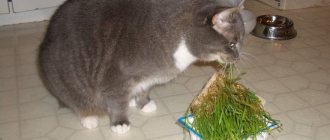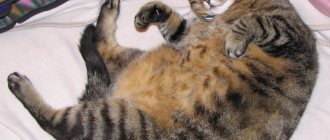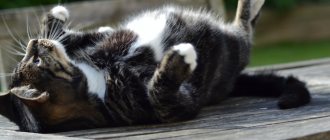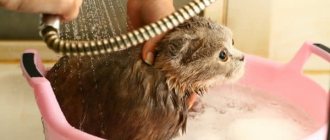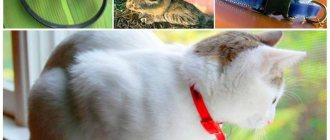Cats have always been considered energetic, active and agile animals. Now many of them spend months in their apartments, dreaming of frolicking in the fresh air. Some owners worry that the cat might get lost in a big city if they take it for a walk.
But there is a way out - you can buy a harness for cats in any store. A harness is a leash of a special design, thanks to which you can walk your pet without carrying it and not worry at all that it will run away. Cat harnesses come in different sizes and designs: the owner needs to choose the best option.
Instructions for making a collar for a cat with your own hands
A collar with a name tag will help you find your pet if it goes missing. To make it, you will need the following devices and materials:
- old belt with buckle;
- blank for a medallion with a loop (if there is no loop, it will have to be drilled);
- a tight ring, preferably made of steel;
- steel plate;
- mounting tape;
- pencil;
- hammer;
- permanent marker;
- alcohol;
- bits with the required letters and numbers.
Then you need to put the bat in the middle and carefully hit the top with a hammer several times. To prevent the letters from blending into the background, they should be covered with a marker, having previously degreased the surface with alcohol. Once the medallion is ready, it must be attached to the ring and secured to the strap
Once the medallion is ready, it must be attached to the ring and secured to the strap.
On the medallion you can place the cat's name, phone number and address of its owner. In this case, it is advisable to place the animal’s name on the front and information about its owner on the back. It is recommended to remove the collar periodically to prevent creases from forming on your pet’s fur.
The simplest collar option for cats with free access to the outdoors is a product made from a nylon sling. To make it at home you will need to take the following materials:
- nylon sling;
- colored ribbon with ornament;
- plastic clasp and buckle;
- half ring
First you need to use a sewing machine to sew the tape to the sling (stitch length - 2 mm).
Then you need to attach the fastener by unfastening it and threading it through one of the elements of the end of the sling. It needs to be folded and sewn to the base of the collar at the fold.
The free end must be threaded through the ring, moving it closer to the beginning. Then it needs to be stitched again across the sling, using the material that was threaded through the fastener to secure the half ring.
Then the end of the sling needs to be slightly bent back and stitched across to secure the buckle.
From the prepared piece of fabric we form 3 blanks. The size of the parts is shown in the picture. The longest part from which the collar will be made should be equal in length to the circumference of the animal’s neck, so you need to take measurements in advance
Please note that the butterfly collar should not put pressure on the cat's neck. Blanks for needlework Let's start creating the butterfly itself. To do this, fold the edges of the largest rectangle towards the center and iron its fold lines
The workpiece should take the shape you need. We work on a large rectangle We repeat the same steps with a small rectangle measuring 5x7 cm. We fold both parts horizontally in half and make a seam at a distance of 5 mm from the edge. We use a sewing machine and turn the pieces inside out so that the seam remains hidden from the inside. We thread the larger piece through the smaller one. The butterfly is ready. Finalizing the butterfly Let's move on to creating the collar itself. Fold the elongated third rectangle, smoothing its edges towards the center. We sew Velcro to the ends of the collar. We make the seam vertical. We form the collar for the cat. Carefully thread the collar through the ring of our butterfly. Putting the details of our work together
To do this, fold the edges of the largest rectangle towards the center and iron its fold lines. The workpiece should take the shape you need. We work on a large rectangle We repeat the same steps with a small rectangle measuring 5x7 cm. We fold both parts horizontally in half and make a seam at a distance of 5 mm from the edge. We use a sewing machine and turn the pieces inside out so that the seam remains hidden from the inside. We thread the larger piece through the smaller one. The butterfly is ready. Finalizing the butterfly Let's move on to creating the collar itself. Fold the elongated third rectangle, smoothing its edges towards the center. We sew Velcro to the ends of the collar. We make the seam vertical. We form the collar for the cat. Carefully thread the collar through the ring of our butterfly. Putting the details of our work together
A charming fabric butterfly collar will become a worthy accessory for your pet. An elegant decoration will come in handy on holidays or special occasions.
Master class on making an accessory
Like any handicraft, making a collar is a very exciting and interesting activity. We offer you a simple and easy process that will not take much of your time.
- First of all, choose the right fabric. It can be any color you like, but the main condition is that it must be dense.
- Prepare a fastener that is easy to use (we discussed their options above), a needle and thread. To decorate the collar, you can take beautiful stones, beads or beads, preferably the same size.
- Measure the volume of the cat's neck with a centimeter. From the selected material, cut a narrow strip, no more than 2 cm.
- Glue or sew pebbles onto the prepared base so that the distance between them is the same. Carefully attach the clasp so that the collar can be easily removed and put on at any time.
When choosing fabric for a collar, pay attention to the density of the material
Using this template, you can easily make a collar of any kind, giving free rein to your imagination. The main thing is to remember a few simple rules:
- Do not use very heavy jewelry. It will be uncomfortable for the cat to walk in a collar that bends it to the ground. It is better to decorate the product with fewer stones or beads.
- If you want to decorate the collar with ribbons, secure them so that they do not interfere with the cat's walking. Carefully secure the tape on all sides, otherwise it may unravel, blocking the cat's view, or, worse, get caught on something.
- When choosing material for a collar, pay close attention to its composition. Some types of fabrics can cause allergies in both humans and cats. Leather is considered the optimal material for a collar.
Tip: To find out if your pet is allergic to fabric, place the selected material near the cat for a while. If the animal does not react for a long time, you can use this fabric to make a collar with your own hands.
Step-by-step instructions: how to put a harness on a cat
Before putting equipment on an animal, you can and should practice on a non-living object: on a suitable toy, figurine, etc. Cats feel the uncertainty and inexperience of the owner and can become very nervous. This will cause the pet to break out, bite, and scratch. If you manage to put on the harness, then out of shock the pet will try to remove the unfamiliar object.
Step-by-step instruction:
You need to carefully pick up your pet. Then the harness is prepared so that it can be immediately picked up and put on the cat. You should sit on the floor or on the sofa. A harness is carefully placed on the animal's body. All actions are performed smoothly, without sudden movements and at the same time quickly. The ammunition straps are tied/snapped/fastened.
Note! After the process is completed, you need to put the animal on the floor and let it get used to the new object. When the kitten gets comfortable, you can attach a leash to the kitten and walk with it around the apartment.
The animal can then be taken outside to a quiet place where there are few people and no cars or other stray animals.
All harnesses are constructed according to the same type
Examples with different types of harnesses
Instructions for use for the classic eight:
- You need to unfasten both straps.
- Then carefully pick up the cat and place it on your lap.
- Put on a harness. First, the strap around the neck is fastened.
- The metal ring to which the leash is attached must be placed strictly between the cat’s shoulder blades.
- After this, you need to fasten the strap, which is located in the torso area.
- At the very end, you need to fasten the leash to a special metal ring.
Step-by-step instructions for a prefabricated figure eight:
The end of the adjustable strap must be passed through a small loop (bridle). Then a free loop is made. Carefully place the cat on your lap and place a loop around its neck. The length of the neck strap needs to be adjusted by yourself
It is important that it is not too loose or too tight. Then the remaining part of the strap needs to be wrapped around the pet’s body and fastened to the desired hole (adjustable in length). At the end a leash is attached.. Important! How to put a harness on a Y-shaped cat will be discussed using two examples, since they come in 2 types: unfastening and non-unfastening
Top articles : Bobtail: a determined character in a charming appearance
Important! How to put a harness on a Y-shaped cat will be discussed using two examples, since they come in 2 types: unfastening and non-unfastening. For the zip-up version:
For the zip-up version:
- You need to separate the two straps. The jumper should be located below in relation to the top of the equipment. You should get a triangle.
- You need to insert the animal’s paws into this triangle.
- First, the straps are connected on the neck, then on the chest.
- After the procedure, a leash is attached.
How to put a non-fastening type harness on a cat:
- The ring intended for the neck must be secured to the pet.
- The paws are inserted into the triangle formed from the harness.
- The jumper located at the bottom should be between the paws exactly in the middle on the chest.
- The ring located on the chest must be fastened.
- You need to attach a leash to the metal ring.
Instructions for vests and overalls:
- You need to catch your pet. Everything is done without sudden movements.
- It is necessary to insert the paws into the holes and fasten the straps if it is a jumpsuit.
- If it's a vest, then simply wrap it around the cat's neck and chest, fastening the carabiners.
Procedure for V-type:
- You need to unfasten the straps and lay out the ammunition on the floor so that you get a diamond shape.
- The cat's paws are inserted into the holes, and the straps are pulled over the chest.
- Then they tie and snap the carabiners on the back.
The V-shaped type is the most difficult to put on a cat.
Step-by-step description of the process for an H-shaped harness:
- 2 rings are unfastened.
- You need to take the cat, put it on your lap and stick its neck into the first ring of the ammunition.
- The harness is aligned like this: the jumper should be exactly in the middle of the back (between the shoulder blades).
- The ring intended for the chest must be wrapped around the body and fastened with a carabiner.
- Then the leash is attached.
Instructions for ammunition with two jumpers:
- You need to sit the cat on your lap and take the harness in your hands.
- The animal's head is inserted into the neck ring, the length of the straight strap is adjusted using a special slider, and the carabiner is snapped into place.
- Both jumpers should be positioned like this: one exactly in the middle of the chest, the other between the shoulder blades.
- The chest part of the harness is wrapped around the body, adjusted to the required length and fastened with carabiners.
- The leash is then attached to the metal ring.
- The harness is on.
Pet leash pattern
Cats love walks just as much as dogs, but they have much worse problems with obedience. Therefore, not a single owner will let a cat out in a park or square, and not everyone has a dacha. Is it really because of this that cats are doomed to sit within four walls and greedily inhale fresh air through a narrow crack in the window?
Of course no. You can take a cat for a walk in the same way as a dog on a leash. You just need a special leash.
What's best for a walk?
An owner who decides to take his pet outside for the first time has to make a difficult choice. Of course, you can carry a cat in your arms and let it go in a quiet place, but the likelihood that the animal will get scared of something and fly up a tree like a bullet is very high. Despite the belief that cats are excellent at climbing trees, not every cat can climb down on its own.
It is much easier to restrain the cat so that it cannot run far. When choosing between a leash and a harness, you should choose the second one, because the cat’s neck is thin and fragile. It is very easy to injure her with a collar. And if you don’t tighten it tightly enough, the animal will simply wriggle out of it, leaving an empty collar in the owner’s hands.
If you plan to walk your cat constantly, then you need to teach it to get ready for a walk from early childhood.
In this case, the animal will not have stress from an unfamiliar place and from putting a strange object on it. Don’t forget that cats are quite freedom-loving and rarely tolerate experiments on themselves.
An easy way to sew a harness
You can buy a harness at any pet store, but if you start training with a kitten, then finding the size for the cat is not easy. It's easier to sew it yourself. And given that the kitten will grow up quite quickly, the cost of purchased equipment will be high. A homemade harness for a cat will be a source of pride for the owner.
Sewing a harness at home is quite simple. To do this, you will need straps or a special tape, which can be bought at any store that sells everything you need for sewing. You will also need to buy a couple of fasteners and a ring to which the leash will cling. And for the leash itself you will need a small carabiner. It can be purchased or removed from a handbag.
Instructions
In order to sew a harness from straps, you need to measure the animal’s neck with a measuring tape. When measuring, you cannot press the tape tightly, since your finger should fit freely between the animal’s neck. You need to add about 2 cm to the measurements for allowances.
The second measurement is taken behind the front legs. Here you will need to secure the clasp, so the length can be made taking into account that the animal may gain a little weight. The strips must be fastened together by crossing at the cat's withers. A ring for a leash is sewn into the same place.
Another strap will run across the animal's chest and connect the other two so that the cat's paws are secured and the pet does not twist out of the harness.
The first strap that will wrap around the neck can be made solid, or you can attach a clasp to it. This will allow you to fasten the neck strap tighter, because if it is without a fastener, you will have to put it on over your head.
The second version of the harness involves the use of a pattern and thick fabric. You can use a piece from old jeans.
How to save money?
This is also very simple. The leash can also be made from a long and strong ribbon or stitched together a strip of fabric. A cat is not strong enough to break a strong leash, but if you are planning to walk in a large area, then you should think about a leash of a couple of meters. You need to make a loop on one edge so that you can put it on the wrist, and firmly sew a carabiner on the other edge.
Best articles: Close-up geographic maps of the Indian Ocean in Russian: Physical and Contour
We knit a harness
The harness is knitted according to the same principle. Change the girth of the neck and the girth behind the front legs. Only in the case of knitting, it is necessary to take into account that the measurements must be as accurate as possible, since in this case there is no way to adjust the harness with clasps.
The easiest way to knit a harness is to crochet. The procedure is simple and even those who have recently picked up yarn can handle it. If necessary, you can watch the video on the Internet.
Decor
- Any owner wants his pet to be the most beautiful. In truth, cats don't care what the harness is decorated with, but owners love to create unique things.
- You can sew various beads onto the harness, glue rhinestones and sequins. The main thing is that they are securely fastened, and the pet cannot chew them off.
- Otherwise, the animal may swallow the bead and get many health problems.
Why buy a device
Unlike keeping a dog, when adopting a cat, the owner does not always plan long walks with his pet in the fresh air and rarely thinks about the need for equipment for this event. Of course, cats do not need such long and daily walks as dogs. But walking them is still useful.
Domestic cats that are constantly indoors suffer from a lack of sunlight. Under its influence, vitamin D is produced in the animal’s skin, which is necessary for the proper development of the bones. In apartment living conditions, it is difficult to provide a cat with the ultraviolet rays necessary for its health.
Walking in the fresh air is useful for prevention in castrated and sterilized animals. Organized exercise is a means of preventing problems with the skeletal system. In addition, cats are very inquisitive and love to explore their surroundings. Staying in the fresh air helps strengthen the immune system and the proper mental and emotional development of the pet.
The benefits of walking for cats are beyond doubt. Veterinary experts recommend physical activity for couch potatoes at least a quarter of an hour daily.
However, a cat famous for its independent character and low motivation to train is difficult to walk without special equipment. When walking in your arms, a frightened animal can cause injury to the owner, run away, climb a tree, or get hit by a car. Without a leash, it is very easy to lose a cat. Therefore, an owner who decides to walk a pet should know how to put a harness on a cat and do it regularly.
Walking an animal on a special device will allow you to control its behavior and ensure safety in a large metropolis. In addition to walking outside, the harness is useful when transporting a cat to a veterinary clinic, in a car, or on public transport. Such ammunition is irreplaceable when traveling out of town or to the country.
Harness fastenings. When purchasing a device, you need to make sure that the fastenings are made of high-quality material and will not bend or break when walking the animal.
When purchasing a harness, you need to pay attention to the choice of leash. There are regular leashes and in the form of a tape measure
The latter provide greater freedom to the pet and allow the cat to explore large areas.
Types of harnesses
At the moment there are several types of harnesses:
- eights;
- vests and overalls;
- Y-harnesses;
- V-shaped harnesses;
- H-type;
- models with two jumpers.
Harnesses can be of different types
Below are more details about each of the presented types.
Eights
The simplest harness design is the figure eight. It consists of two (or more) straps fastened together in one place. For this characteristic feature the ammunition got its name. This type is divided into 2 subtypes: classic (finished look) and prefabricated (customizable length).
Y-harnesses
A Y-harness is the same as a figure eight harness, only it has a jumper on the chest. The scheme is exactly the same as the previous version: two (or more) straps are fastened together in one place.
Vests and overalls
Vests and overalls are decorative options. They cost more than regular models. Sewn from cotton, linen, synthetics. The length of the fasteners on the neck and stomach is adjusted using special sliders, which are installed on the main strap with a plastic carabiner.
Note! The design is different. You can choose a model to suit your taste and color
V-harnesses
The V-shaped type of ammunition is similar to a diamond (when unfolded). Here 2 rhombuses have a common base. The clasp is on the back. It can be made in the form of two carabiners made of plastic or metal or in the form of rings that need to be fastened together using a carabiner on the leash.
For your information! This is considered to be the simplest and most common model.
H-view
Here 2 rings are connected to each other by a jumper, which will be located on the back of the animal. It is made from nylon, tightly sewn together threads.
Models with two jumpers
The least common models are those that have 2 jumpers: one on the back, the other on the chest. As a rule, they are more expensive than other types of this type of ammunition (with the exception of vests and overall models).
Note! Models are sold with and without a leash. The cost of the product in the pet store also depends on this.
How does a harness with two jumpers work?
Belts
The harnesses from the belts are different. Figure-of-eight type made of two rings, with fastening between the shoulder blades. One is worn around the neck, and the other is fixed on the torso.
There are options with straps crossing across the chest to reduce pressure on the throat if the mustachioed person pulls too hard on it.
Or a connecting strap on the back. Their advantage is that they can always be adjusted to suit the age and changing weight of the animal.
A large number of fastenings and belts creates the impression of a complex structure. Do not worry. You can assemble a harness for a walk in a couple of seconds, you just need to practice properly, not on a cat. Only once you get the hang of it, begin to accustom your animal to it.
How to accustom a cat to a harness and leash
It is better to accustom a cat to a harness from childhood, but this is also possible in adulthood. It’s good if your cat wears a collar, in which case she will take the harness calmly:
- First, introduce your cat to a new object. Let him sniff, examine, touch - the cat must make sure that he is safe.
- By the way, if the harness has an unpleasant and pungent odor, the cat will definitely not like it. Wash it, air it out, freeze it in winter, bake it in the sun in summer, in general, do everything to get rid of this smell. Then place the harness next to the cat's toys or in the basket where the cat sleeps.
- When the harness is perceived as your property, start putting it on. If the experiment is successful, be sure to praise the cat and pet it. Let the cat walk around in the harness, play, eat, or even sleep, in general, get used to feeling it on its body. The time spent in the harness should be increased gradually.
- If your pet resists, it is best to calm him down first, distract him, and then try again. We must not allow the “harness – unpleasant sensations” connection to become established in the cat’s brain.
- Well, now the cat is used to the harness, it’s time to accustom it to the leash. First, attach him to the harness and let him walk around the apartment so that he can freely follow it. This should only be done under your supervision, because you need to make sure that the leash does not get caught on anything. Otherwise, the cat may feel trapped, try to free itself, panic and, ultimately, begin to perceive the leash as a dangerous object that it is better not to mess with.
- If this stage was successful, teach the cat to follow you on its heels. Take a leash and follow the cat around the room.
- It's time to conduct field tests. The place for walking should be quiet and safe, preferably away from a dog walk, so that irreparable incidents do not occur. Be patient and let the cat get comfortable, do not try to immediately lower it to the ground. If she is scared of something, pick her up, calm her down and go home. The first walks should be short, increase the time spent outside gradually.
If you do everything correctly and without coercion, your cat will love walks, and they will bring you both many pleasant moments.
How to choose a ready-made veterinary collar
Protective cones for cats are standardized in terms of dimensions; a total of 7 sizes are available.
READ Do-it-yourself aquarium cover with lighting
At the same time, there are two main types of cones - cheaper and more expensive. The first are translucent plastic products with not very convenient fasteners. The second are opaque or translucent fabric products with Velcro. Both types can be fitted with a bandage or collar, which can act as an additional restraint. They are identical in efficiency.
Best articles: Bombay cat: history, character, description, maintenance, health and purchase
The simplest and most effective solution is to buy a ready-made veterinary cone at a pet store.
Popular models - characteristics, price
- Harness for cat ROGZ ReflectoCat S;
- Dezzie Kitten Kit;
- Hunter Smart cat harness Stripes;
- Trixie harness for kittens;
- Trixie harness with leash for large cats.
Cat harness ROGZ ReflectoCat S
The polyester model comes complete with a leash (1.8 m). Side fasteners made of acetate plastic open easily and do not damage the animal’s fur.
The carabiner connecting the harness to the leash opens freely with strong tension - this is important if the pet is stuck on a tree or fence. The degree of ease of opening the lock is adjusted depending on the weight and activity of the animal
The product has a bright design and is equipped with a bell. The width of the strips is 1.1 cm.
- Plus: a reliable carabiner with an opening adjustment system.
- Disadvantage: high cost.
Price: 1188 rub. More details about the product
Dezzie Kitten Kit
The kit is designed specifically for kittens. The kit includes a harness (23x43 cm) and a leash for cats (120 cm). The width of the straps is 0.8 cm.
The product is made of pink nylon. A pattern in the form of a cat silhouette is applied along the entire length of the product. The material from which the model is made does not rub the kitten’s skin, and the convenient side carabiners do not injure the animal’s fur.
The harness is connected to the leash with a metal carabiner, which guarantees a reliable connection.
- Plus: cheap.
- Disadvantage: preliminary training of the animal is necessary.
Price: 394 rub. More details about the product
Hunter Smart cat harness Stripes
Very light nylon harness with a leash made of multi-colored material. Suitable for cats and small breed dogs.
Plastic sliders on the slots adjust the dimensions of the product and ensure reliable fixation in the selected position.
The length of the leash is 1.2 meters. Suitable for cats with chest circumference – 22-46 cm, neck circumference – 22-33 cm.
- Plus: adjustable size.
- Cons: narrow straps.
Price: 740.02 rub. More details about the product
Trixie harness for kittens
A comfortable and reliable harness for kittens made of nylon from a well-known German manufacturer. The product is sold complete with a leash. The length of the leash is 1.2 meters. The product evenly distributes the load from the leash onto the kitten's chest and shoulders.
The adjustment system allows you to adjust the size of the harness to your pet. Product dimensions: 21×32 cm. Strap width – 0.8 cm.
- Plus: does not rub the skin and does not injure the coat.
- Disadvantage: Replacement is necessary when the animal grows.
Price: 423 rub. More details about the product
Trixie harness with leash for large cats
The model is designed specifically for large breed cats. Product material – nylon. The sizes are smoothly adjusted using special plastic sliders on the slots. The side carabiners are made of high-quality plastic, are easy to unfasten and do not injure the cat’s fur and skin.
The leash is connected to the product with a reliable metal fastener. Suitable for animals with a chest circumference of 34-57 cm. The width of the stripes is 1.3 cm.
Price: 675 rub. More details about the product
How to do it yourself
You can make a neck collar for a pet yourself if you suddenly need such a collar urgently, but you can’t buy it or the store doesn’t have the appropriate size. The simplest materials are suitable for this: cardboard, plastic, dense material.
From fabric
The advantage of a fabric collar is its softness; it serves as a pillow for the cat. But if she tries to take it off, make a tougher option. For self-production you will need: tape measure, scissors, material, marker, stapler, tape.
Step by step steps:
- Take two measurements: the first is neck circumference; the second is the length of the head (from the collar to the tip of the nose).
- Make a template out of paper, draw an inner semicircle with a compass, which corresponds to the first measurement, retreat to the distance of the second, mark the outer semicircle. Add an extra 2.5 cm for seams.
- Cut out the paper pattern according to the dimensions.
- Cut out two parts of the product onto the fabric.
- Proceed with assembly.
- Fold the right side out, place a piece of cardboard between the pieces of fabric, connect, sew the two halves together.
- Instead of cardboard, you can use another dense layer: felt, non-woven fabric, and sew all the blanks together with a diamond-shaped seam.
- Connect the edges with Velcro.
- Make lacing from fabric or, better yet, from flexible plastic on the inner edge to secure it to the animal’s neck.
Sew a thick fabric border along the outer edge. Another option is to buy a plastic collar and adjust the dimensions according to the dimensions of the animal. Then sew on thick soft fabric.
From the bottle
The product will be flexible and durable, the protective barrier will last a long time. For this you need: a plastic bottle of a suitable size, tape, adhesive tape or string. First take your measurements. Then cut out the parts from paper. Cut out a cone according to the paper diagram. Make holes using a nail or a thick needle.
Second way:
- On the side of the neck, mark with a marker a diameter equal to the circumference of the cat’s neck.
- Cut off this part and measure the length of your pet's head.
- Cut off the remaining plastic.
- Cut lengthwise and try it on the animal.
- Make holes along the cutting line and thread lacing made of soft fabric.
You can secure the Velcro fastener with a stapler. Cover sharp cuts with adhesive tape or tape.
Quick option
For an emergency, a cardboard cone is suitable, although it is not intended to last for a long time. Instructions:
- Prepare thick cardboard (shoe boxes, household appliances).
- Take measurements from the animal.
- Mark them on cardboard.
- Cut according to the design with scissors.
- Wrap the edges of the structure with tape.
- Secure the cone parts with adhesive tape.
- Make loops for the collar.
This method is suitable when the animal has not yet recovered from anesthesia.
Wearing rules
Several conditions for wearing the structure must be observed:
- Heavy and voluminous collars should not be worn, as this will limit the animal’s movements too much.
- The size must be appropriate for the pet, for example, for a small kitten you need to buy or make a suitable cone.
- Cover sharp edges with electrical tape, adhesive tape, or tape, otherwise the cat may get hurt.
- Do not let your pet outside, it is unsafe.
- Make sure that the animal can easily reach the bowl of food and drink.
- If the pet refuses to eat, feed it by removing the collar.
- Inspect the skin under the collar while wearing it.
- Brush your pet, because because of the barrier he cannot groom himself.
- Provide free living space.
- Isolate from other animals.
- Wear until recovery, when the wound has completely healed and the veterinarian allows you to get rid of the collar.
You should put on the collar carefully, without making sudden movements; it is better to do this together




